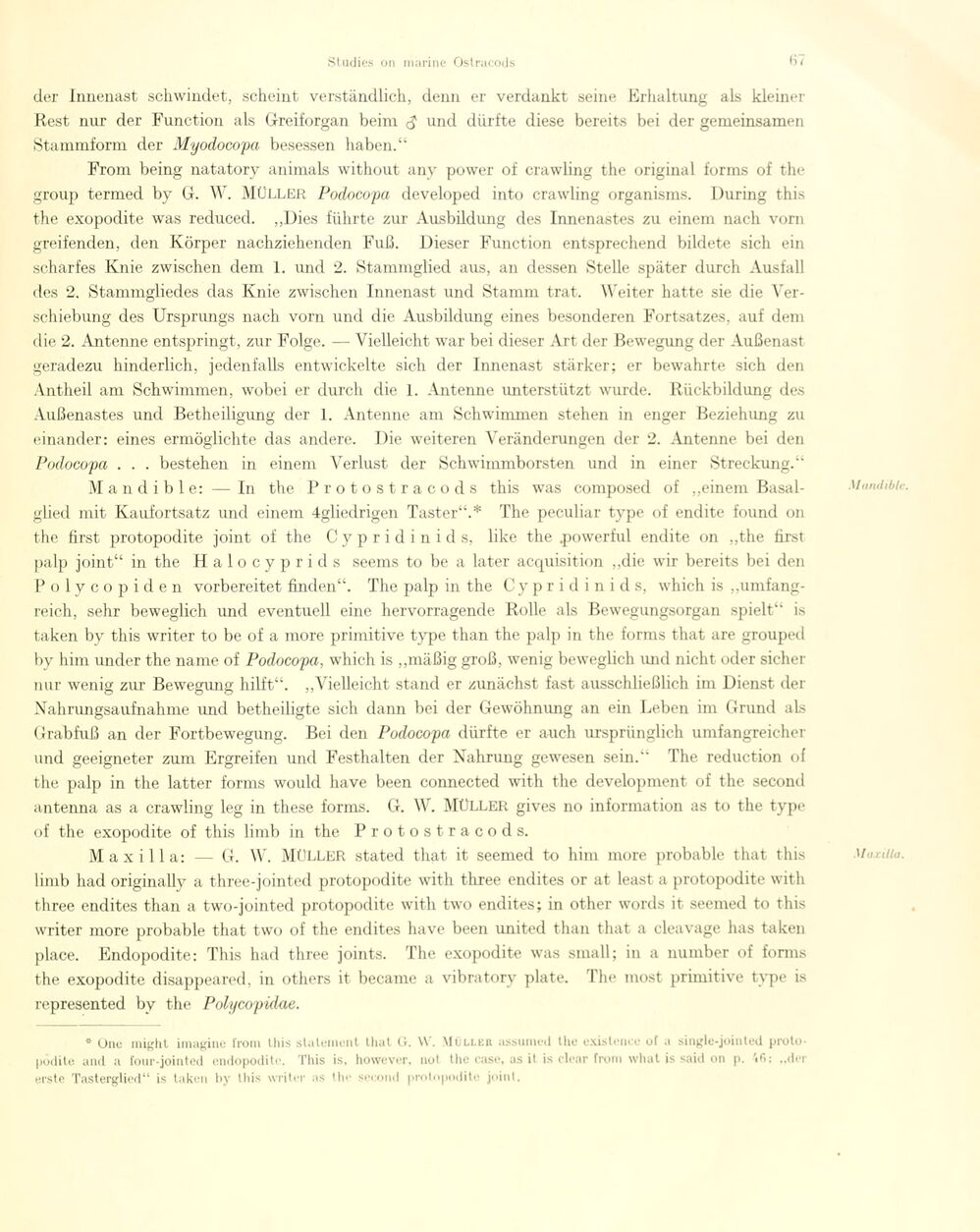
Full resolution (JPEG) - On this page / på denna sida - Sidor ...

<< prev. page << föreg. sida << >> nästa sida >> next page >>
Below is the raw OCR text
from the above scanned image.
Do you see an error? Proofread the page now!
Här nedan syns maskintolkade texten från faksimilbilden ovan.
Ser du något fel? Korrekturläs sidan nu!
This page has never been proofread. / Denna sida har aldrig korrekturlästs.
der Innenast schwindet, scheint verständlich, denn er verdankt seine Erhaltung als kleiner
Rest nur der Function als Greiforgan beim <J und dürfte diese bereits bei der gemeinsamen
Stammform der Myodocopa besessen haben.“
From being natatory animais without any power of crawling the original forms of the
group termed by G. W. MÜLLER Podocopa developed into crawling organisms. During this
the exopodite was reduced. „Dies führte zur Ausbildung des Innenastes zu einem nach vorn
greifenden, den Körper nachziehenden Fuß. Dieser Function entsprechend bildete sich ein
scharfes Knie zwischen dem 1. und 2. Stammglied aus, an dessen Stelle später durch Ausfall
des 2. Stammgliedes das Knie zwischen Innenast und Stamm trat. Weiter hatte sie die
Verschiebung des Ursprungs nach vorn und die Ausbildung eines besonderen Fortsatzes, auf dem
die 2. Antenne entspringt, zur Folge. — Vielleicht war bei dieser Art der Bewegung der Außenast
geradezu hinderlich, jedenfalls entwickelte sich der Innenast stärker; er bewahrte sich den
Antheil am Schwimmen, wobei er durch die 1. Antenne unterstützt wurde. Rückbildung des
Außenastes und Betheiligung der 1. Antenne am Schwimmen stehen in enger Beziehung zu
einander: eines ermöglichte das andere. Die weiteren Veränderungen der 2. Antenne bei den
Podocopa . . . bestehen in einem Verlust der Schwimmborsten und in einer Streckung.“
Mand ib le: — In the Protostracods this was composed of „einem
Basalglied mit Kaufortsatz und einem 4gliedrigen Taster“.* The peculiar type of endite found on
the first protopodite joint of the Cypridinids, like the .powerful endite on „the first
palp joint“ in the Halocyprids seems to be a later acquisition „die wir bereits bei den
Polycopiden vorbereitet finden“. The palp in the Cypridinids, which is
„umfangreich, sehr beweglich und eventuell eine hervorragende Rolle als Bewegungsorgan spielt“ is
taken by this writer to be of a more primitive type than the palp in the forms that are grouped
by him under the narne of Podocopa, which is „mäßig groß, wenig beweglich und nicht oder sicher
nur wenig zur Bewegung hilft“. „Vielleicht stand er zunächst fast ausschließlich im Dienst der
Nahrungsaufnahme und betheiligte sich dann bei der Gewöhnung an ein Leben im Grund als
Grabfuß an der Fortbewegung. Bei den Podocopa dürfte er auch ursprünglich umfangreicher
und geeigneter zum Ergreifen und Festhalten der Nahrung gewesen sein.“ The réduction of
the palp in the latter forms would have been connected with the development of the second
antenna as a crawling leg in these forms. G. W. MULLER gives no information as to the type
of the exopodite of this limb in the Protostracods.
Maxilla: — G. W. MÜLLER stated that it seemed to him more probable that this
limb had originally a three-jointed protopodite with three endites or at least a protopodite with
three endites than a two-jointed protopodite with two endites; in other words it seemed to this
writer more probable that two of the endites have been united than that a cleavage has taken
place. Endopodite: This had three joints. The exopodite was small; in a nuinber of forms
the exopodite disappeared, in others it becarne a vibratory plate. The most primitive type is
represented by the Polycopidae.
* Une might imagine from this statement that G. W. Müller assumed the existence of a single-jointed
proto-pôdite and a four-jointed endopodite. This is. however. not the case, as it is clear from what is said on p. ifi: „der
erste Tasterglied“ is taken by this writer as the second prolopodite joint.
Mantliblc.
Maxilla.
<< prev. page << föreg. sida << >> nästa sida >> next page >>